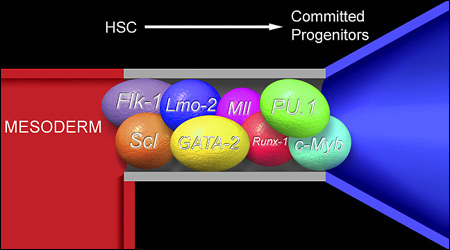Gene responsible for blood supply found
Blood cell formation depends on gene previously linked to leukemia

Researchers at Harvard-affiliated Dana-Farber Cancer Institute have pinpointed a crucial gene on which the normal development of the body’s entire blood system depends. If the gene is absent, even the most basic blood stem cells cannot be generated. In a mutated form, this gene can cause a rare and devastating form of leukemia.
Called MLL, the gene makes a protein that regulates the activity of a number of other genes involved in proper development of tissues and organs during embryonic life. The experimental results being published in the March 16 issue of Developmental Cell demonstrate that MLL is necessary for the development of the “master” stem cells that generate all the mature blood cells.
The team led by Patricia Ernst and Stanley Korsmeyer reports that the discovery of the gene’s critical role should help unveil important mechanisms in how the blood system develops, and could lead to ways of manipulating it in normal and cancerous conditions.
“The MLL gene, which is required to make all blood cells, is also a cause of a distinct human leukemia, suggesting that the blood’s earliest stem cells are involved in this cancer,” explains Korsmeyer, who is director of the Program in Molecular Oncology at Dana-Farber and a Howard Hughes medical investigator.
MLL stands for “mixed lineage leukemia,” an aggressive, often fatal, type of blood cancer that affects a small number of infants and some adults who have relapsed following treatment for leukemia. Dana-Farber researchers identified this rare cancer in 2002 on the basis of its genetic profile – a specific pattern of gene activity in the cancer cells. It is caused by a mutation, or damage, in the MLL gene that results when the chromosome on which it resides breaks apart at that location. This chromosomal mishap leaves the MLL gene stuck in the “on” position so that white blood cells are overproduced, resulting in leukemia.
Scientists have previously found that chromosome breaks can damage other genes necessary for blood system development, and at least four such genes have been identified. The Korsmeyer group used embryonic stem cell methods to create cells in the laboratory as well as mice lacking the MLL gene, and showed that the gene’s absence had profound effects on the development of the blood-forming system – known as the hematopoietic system – that functions in embryonic, fetal, and adult life.
A single hematopoietic stem cell can generate many different types of blood cells. These include red blood cells, which carry oxygen to the body, and at least seven different types of white blood cells, which help heal wounds and form the immune defenses. Adult animals that lacked the MLL were unable to manufacture the various types of mature cells, and fetal animals without the gene could not generate the critical blood stem cells, says Korsmeyer, who is also the Sidney Farber Professor of Pathology and professor of medicine at Harvard Medical School.
These results show, the authors write, that MLL is part of “a select set of genes required for all definitive blood lineages in the embryo.” The protein made by the MLL gene is known to regulate some of the master genes, known as HOX genes, that guide the formation of body tissues and organs. Malfunction of these genes has been implicated in several types of cancer.
The paper’s other authors are Jill K. Fisher, William Avery, and Stacey Wade of Dana-Farber, and Daniel Foy of Children’s Hospital Boston.




